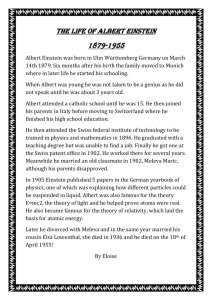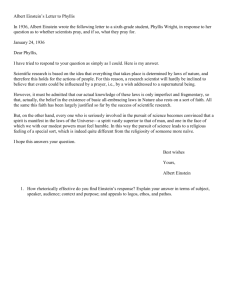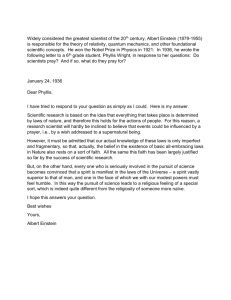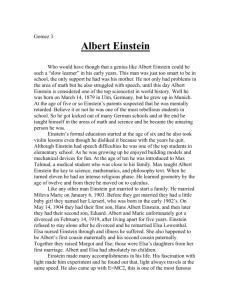Document 8537772
advertisement
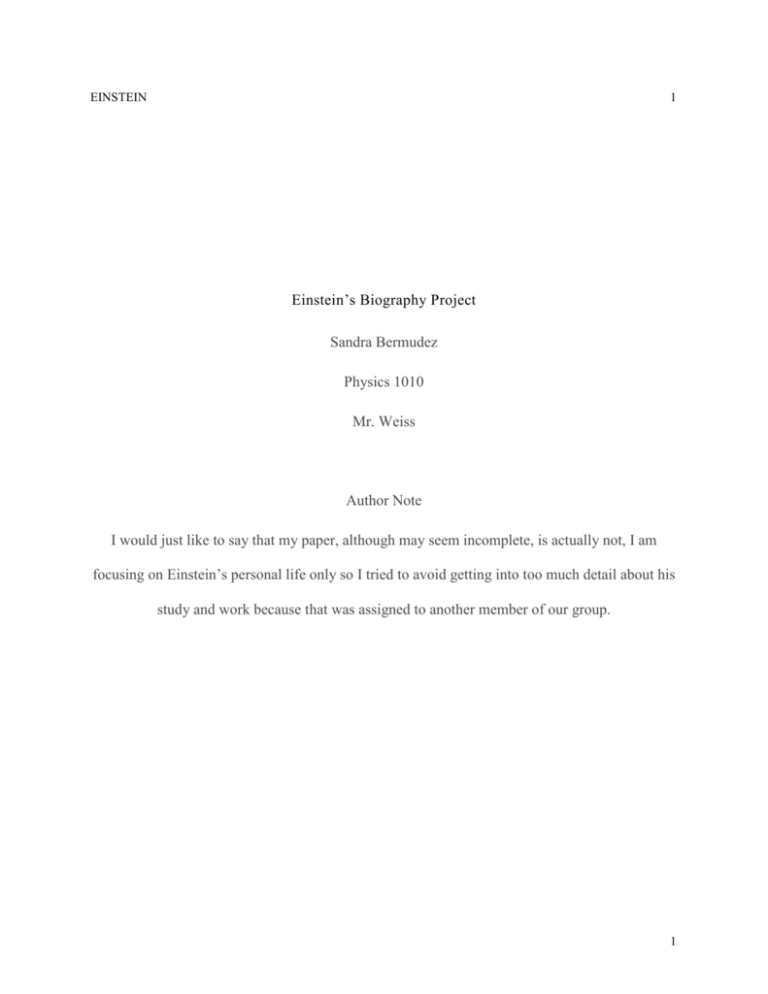
EINSTEIN 1 Einstein’s Biography Project Sandra Bermudez Physics 1010 Mr. Weiss Author Note I would just like to say that my paper, although may seem incomplete, is actually not, I am focusing on Einstein’s personal life only so I tried to avoid getting into too much detail about his study and work because that was assigned to another member of our group. 1 EINSTEIN 2 Notes FATHER Hermann Einstein, salesman and engineer who, with his brother, founded a company that manufactured an electric equipment in Munchin Germany. MOTHER Pauline Koch, ran the family household SISTER Maja Einstein, born around 1881? 1ST TUTOR, Max Talmund medical student that became a tutor for Albert, introduced him to higher mathematics and philosophy and shared a book that aroused his curiosity about electricity and the way it travels. Around the age of 16, Albert began to wonder what a light beam would look like if you ran alongside it at the same speed. If light were a wave, the light beam would appear stationary, yet, in reality, it is moving. This question of the relative speed to stationary observer and the observer moving with the light was a question that would dominate his thinking for the next 10 years. 2 EINSTEIN 3 Einstein’s Biography Project EARLY LIFE Born March 14, 1879 in Ulm, Wurttemberg, Germany, Albert Einstein grew up in a middle class Jewish family. He attended Luitpold Gymnasium, an elementary school, which, although made him feel alienated, did help him find discover his fondness of classical music. In later years, Albert E. would write about two events that a marked effect on his childhood: the first was the discovery of a compass, around 1884, he was astonished and curious about the invisible forces that turned the needle of a compass, the second event, around 1891, he discovered a geometry book, which he read over and over again. Around 1889, the Einstein family took in a medical student named Max Talmund, who introduced Albert E. to higher mathematics and philosophy. One of the books shared with young Albert E. was a children’s book that introduced his mind to electricity and aroused his curiosity of the way it travels. Around the age of 16, Albert E. began to wonder what a light beam would look like if you ran alongside it at the same speed. If light were a wave, the light beam would appear stationary yet, in reality, it is moving. This question of the relative speed to stationary observer and the observer moving with the light was a question that would dominate his thinking for the next 10 years. Around 1894 the company his father and uncle founded, Elektrotechnische Fabrik J. Einstein & Cie, failed and the Einstein family moved to Milan, Italy. Albert E. was left behind at 3 EINSTEIN 4 a relatives boarding house so that he can finish his education, unfortunately Albert E. withdrew from school when he realized that he would be forced to serve the military when he turned of age, and made his way to his family in Italy. Once he was reunited with his family, he applied at a school named Eidgenossische Polytechnische Schule, in Zurich, Switzerland, since he lacked any kind of equivalent of a high school diploma, he did fail much of the entrance exam, however did an exceptional job when it came to mathematics and physics and because of this, he was admitted with the condition of finishing his formal schooling first. Albert E. attended a high school in Aaron, Switzerland that was ran by a man named Jost Winteler and in 1896, graduated. Around this time he fell in love with Winteler’s daughter Marie, and also renounced his German citizenship to avoid military service and enrolled at Eidgenossische Polytechnische Schule. ADULTHOOD Albert E. is said to have claimed some of the happiest years of his life while attending his school in Zurich where he met some of his most loyal, lifelong friends and future wife, Mileva Maric, a fellow physics student from Serbia. After graduating from his school in Zurich around the 1900s, Albert E, faced hard times such as not being able to find employment due to the animosity of some of his professors and losing the few jobs he had managed to find. This made things even worse for him since, although his relationship with Maric deepened, despise his parents opposition, he was not able to marry her or support a family without a job. Albert E. was said to have a daughter, around 1902, named Lieserl who either died or was given up for adoption, I was not able to find any more detail on her, or any of Albert E.’s children. 4 EINSTEIN 5 Around 1900s, Marcel Grossman’s ( lifelong friend ) father offered him a position as a clerk in the Swiss Patent Office in Bern Switzerland. Around this time, Hermann Einstein became terminally ill and, before dying, gave Albert E. his blessing for marriage. On January 6 1903, Albert E. and Mileva Maric were married. Shortly after, In 1904, Maric gave birth to Hans Albert and not long after him, about 1910, she gave birth to Eduard. In 1905 he received his doctorate degree in physics from the University of Zurich. While working at the Swiss Patent Office, Albert E. quickly mastered his job and continued to ponder his theories, those of which I will not go into detail because one of my group members is going over his accomplishments, theories, studies etc. Although I will not go into detail, I will say that Albert E.’s career kicked off when he was able to gain the attention of one of the most influential physicist of his generation: Max Planck. Once Planck confirmed his theories he quickly rose in the academic world and was offered several prestigious positions. Unfortunately, as Albert E.’s fame rose, his marriage fell apart due to several reasons such as his constant traveling, his intense study, the arguments about their children and their family’s struggling economic situation. Albert E. began an affair with, and later married, a cousin named Elsa Lowenthal, who died in 1936. In 1919, he divorced Maric with an agreed settlement stating that he would give her the money he would receive if he ever won a Nobel Prize. Throughout the following years Albert E. spends his time occupied with his study, research and touring the world speaking of his theories. Sometime around 1932 Hitler denounced him and his theories as Jewish Physics and is listed on an assassination target list. In December 1932, Albert E. leaves Germany and takes a position at the institute for Advanced Study at Princeton, New Jersey. It is here that he spends the rest of his career trying to further develop his theories. In 1935, Albert E. is granted permanent residence in the U. S. 5 EINSTEIN 6 During the summer of 1939, Albert E. and another physicist named Leo Szilard write a letter to Roosevelt to alert him of a possible Nazi bomb. This letter may have been the key factor into the investigation of the development of nuclear weapons. Shortly after this meeting, The manhattan Project was initiated. In 1940, Albert E. becomes an American Citizen. DEATH On April 17 1955, Albert E. suffered from abdominal aortic aneurysm and experienced internal bleeding, he was taken to the University Medical Center at Princeton for treatment but refused surgery accepting his fate and saying that he would rather accept his fate elegantly. On April 18, 1955, at the age to 76, Albert Einstein died at the hospital. During the autopsy, Thomas Stoltz Harvey removed his brain for preservation and for the future study of doctors of neuroscience. His body was cremated and his ashes were scattered. His brain is located at the Princeton University Medical Center. 6 EINSTEIN 7 REFERENCES Albert Einstein - Biographical. (2015). nobelprize.org website. Retrieved, Aug 02, 2015 from http://www.nobelprize.org/nobel_prizes/physics/laureates/1921/einstein-bio.html Albert Einstein. (2015). The Biography.com website. Retrieved, Aug 01, 2015, from http://www.biography.com/people/albert-einstein-9285408. 7
